![]() Page is locked
Page is locked
Table of Contents
TrentSim Versions
Timetables
Screenshots
Map of Trent
Introduction
New & Special Features
Start-up Options
Layout
Clay Cross Workstation
Trent Workstation
Reference Section
Signal Box Prefix Codes
Known Issues
Credits
Trent
| THIS SIMULATION IS OBSOLETE AND HAS BEEN WITHDRAWN FROM THE DOWNLOAD AREA |
Sim Versions
| Version | Status | Scroll/Views | Published | Comments |
|---|---|---|---|---|
| V2.132.3.8121 | Donationware | S | 09/07/10 | No longer available to download |
Timetables
| Title | Published | Author | Comments |
|---|---|---|---|
| Trent 2007 v3.9 | 05/02/09 | KurtDS | Available from Download section and bundled with V2.132.3.8121 |
| Trent May 2009 | TBC | Noisynoel | Available from Download section |
| Trent Compatible Sheffield/Trent 2009 | TBC | Noisynoel | Available from Download section |
| Trent 'Fictional 1500' v1 | 06/08/10 | peterb | Available from Download section |
Welcome to Trent, the panel at the heart of the East Midlands and the Nottinghamshire coalfields. Some people claimed Trent would be a dull panel to simulate. Well, where else will you see a triple triangle junction, automatic shunt aspects and trams? You'll be surprised of how complex this area is.
=
Screenshots
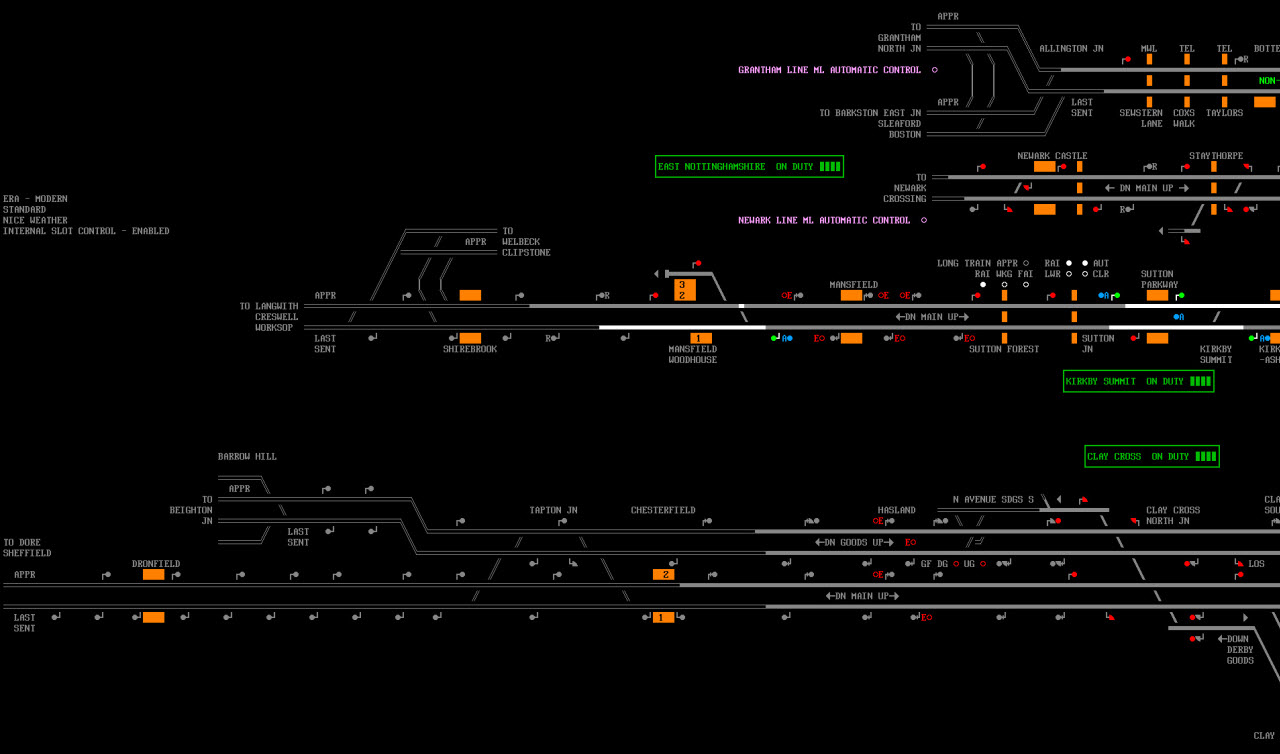
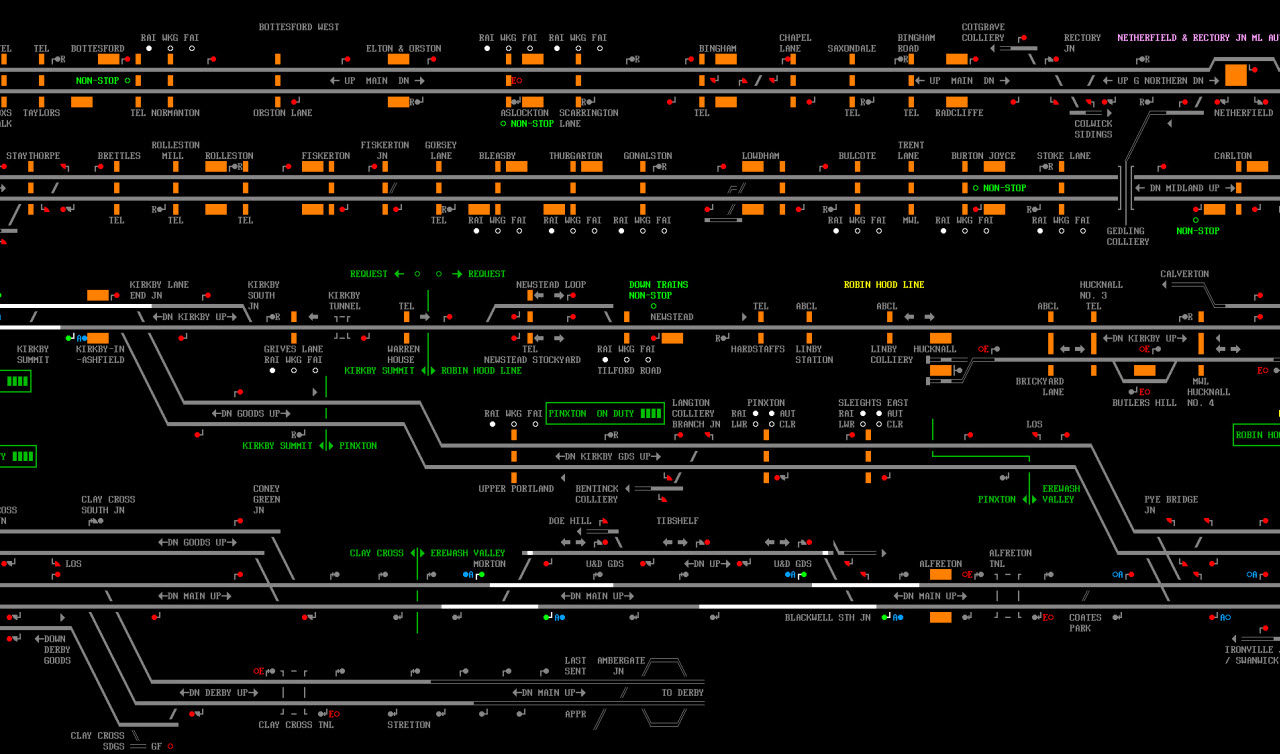
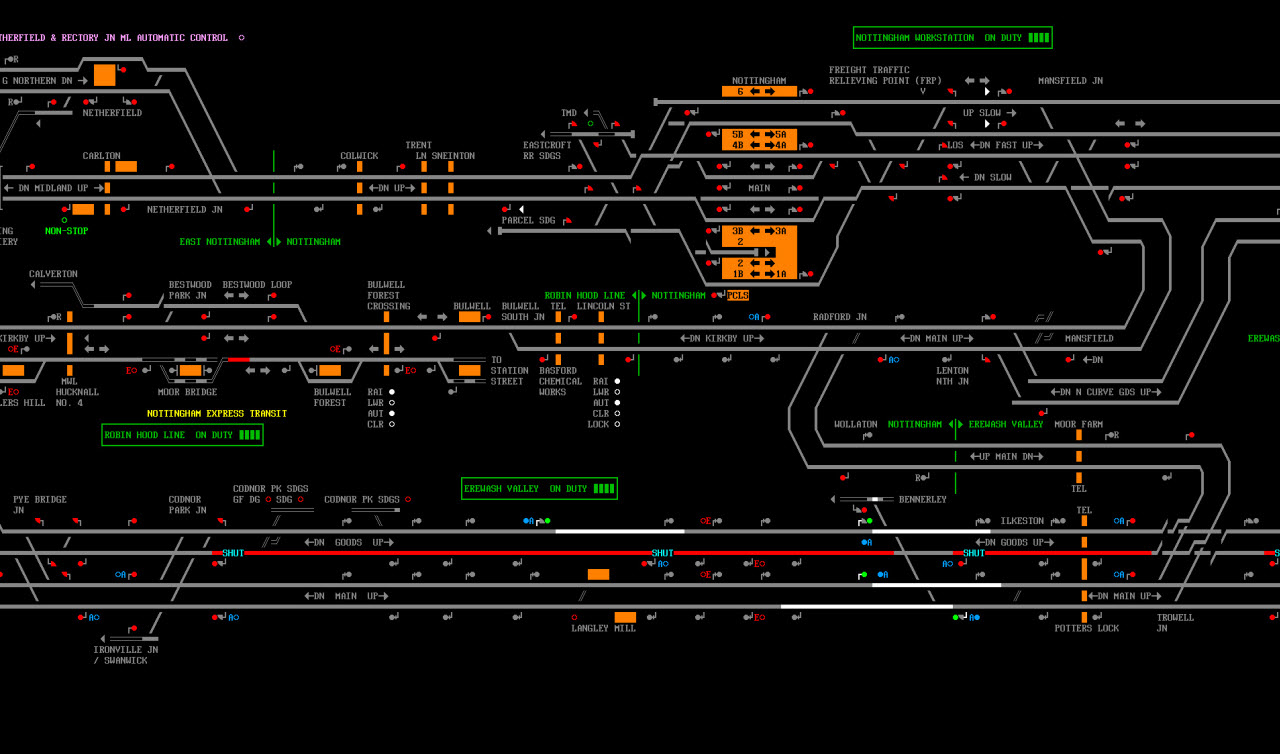

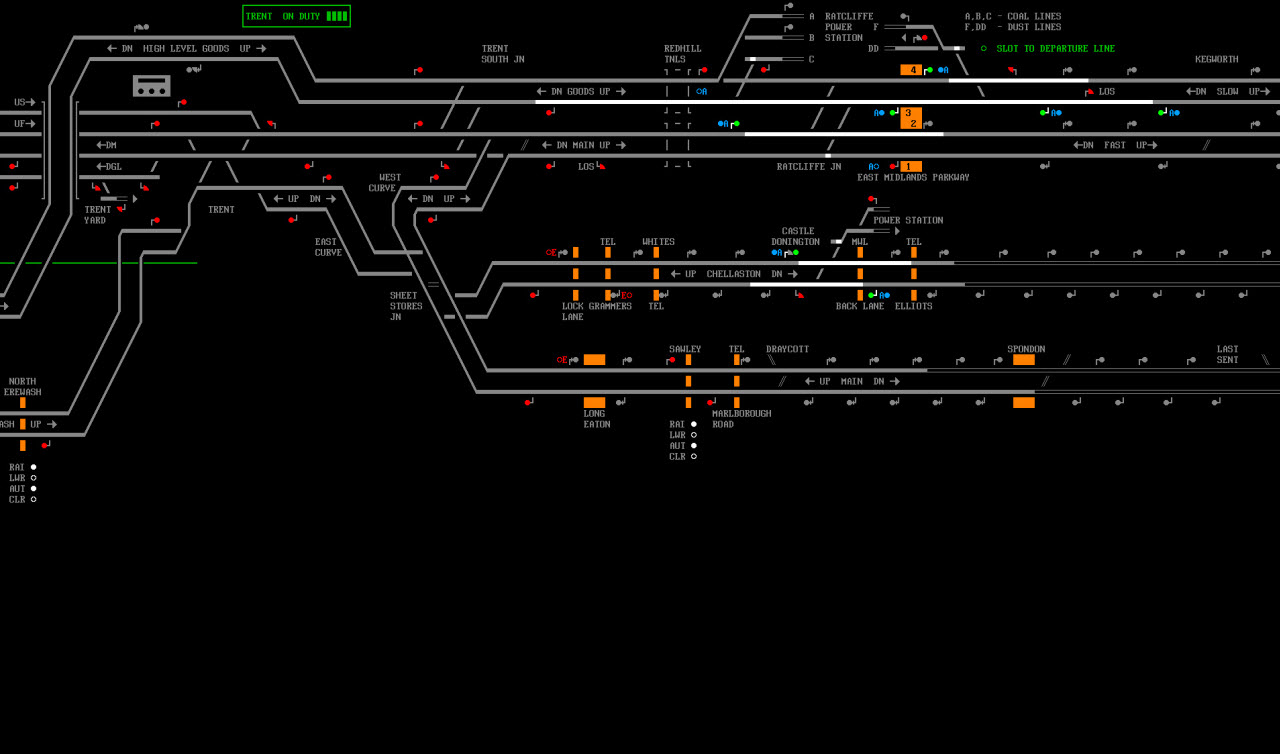
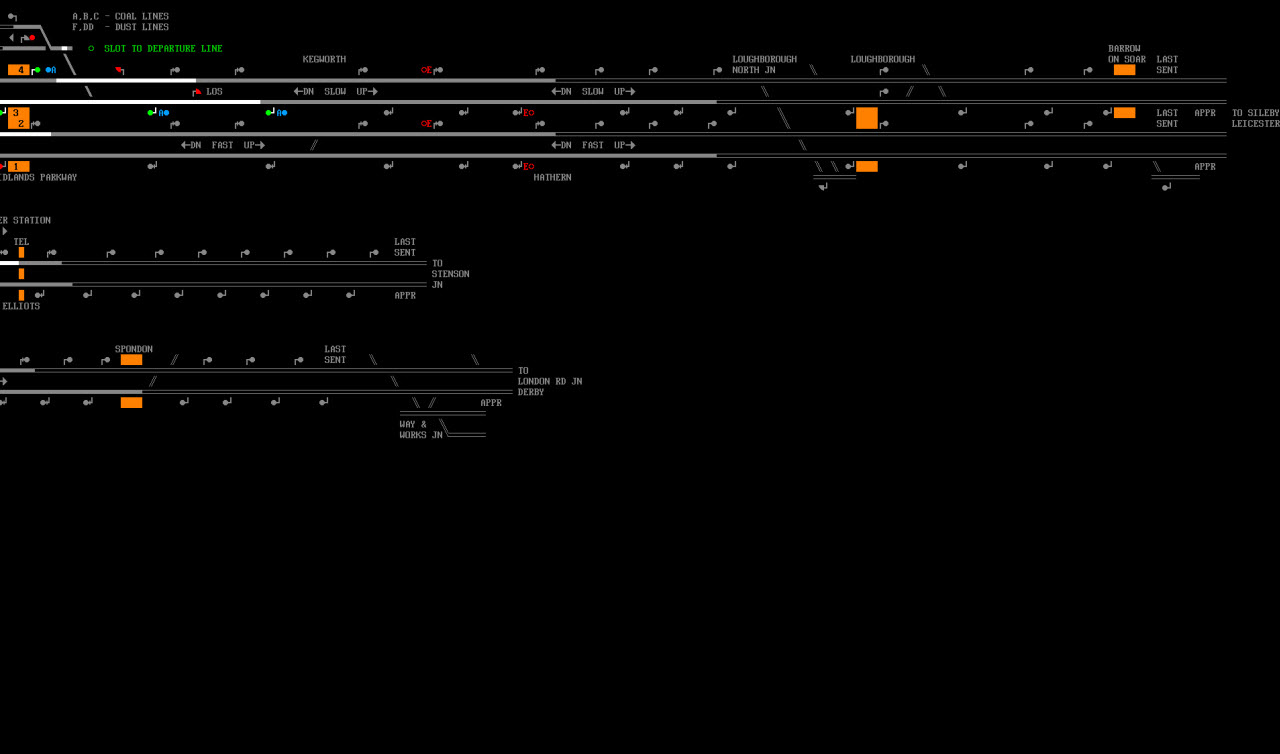
=
Map of Trent
Click here to view a few points of Trent marked on Google Maps.
Introduction
The real Trent, which opened in 1969, controls the area from just north of Loughborough to the south, Nottingham to the east, just short of Chesterfield in the north and Spondon in the west. The SimSig version of Trent also includes Kirkby Summit panel, encompassing Mansfield, and a number of mechanical boxes to the east up to Newark and Allington. The southern half of the Robin Hood line is covered. A surprise to the research team is that Trent also has some control over the northern part of the Nottingham Express Transit system; this is because the tram and Robin Hood line run parallel and share a number of level crossings .
At the time of opening, coal was king in the area, with numerous collieries in the northern area. Trains took this to Toton, which had several major marshalling yards, and then this in turn was taken to several power stations which were dotted along the River Trent, and further afield. Sadly, a lot of the collieries closed in the 1980s, along with the closure of Nottingham and Castle Donnington power stations. Today there are no open coalmines within the area, the only ones are to the northeast of Mansfield.
Because of the high proportion of freight, a lot of the lines are goods only lines. These were operated under permissive regulations, which allowed more than one train into a section at a time. When the panel was originally opened, permissive working existed on all of the goods lines, this was accompanied by an unusual feature, automatic calling on lights. In the modern period, the only stretches remaining of permissive working are the up goods between Bennerley and Trowell, and the up goods between Mansfield Jn and Beeston.
Following a derailment in the 1980s, the down goods line through Erewash valley was taken out of use, although most of the track and the signals remained in situ until August 2007. (Indeed, I recall my first journey along Erewash in the 1990s when all of a sudden we passed a tree growing out of the middle of the down goods line!)
When Trent opened, Sleight East and Lincoln St were fringe boxes. The original line from Bestwood to Kirkby closed in the 70s, but was reopened as the Robin Hood line for passenger trains in the 90s, initially as far as Newstead, then to Mansfield Woodhouse and finally to Worksop. Initially, this was not controlled by Trent, but when NET was constructed, the mechanical boxes at Lincoln St and Bestwood were closed, the single line extended to Bulwell South, and a new sub panel at Trent opened. The mechanical boxes between Kirkby and Shirebrook were also closed and replaced by a panel at Kirkby Summit (unattractively housed in a portacabin).
The two boxes on the goods lines at Pinxton and Sleights East remained however, until August 2007. These is little traffic and it was often remarked that signallers there sometimes worked a whole shift without a single train.
In August 2007, the first phase of the East Midlands multi million pound resignalling project started, which will eventually see the closure of Trent, Kirkby Summit as well as Derby, Leicester and all of the mechanical boxes remaining in the area. This first phase involved remodelling Pye Bridge and Trowell Jn, and converting the up goods to a bi-directional slow line. The second phase involved remodelling Clay Cross, and the transfer of Tapton and Chesterfield from Tapton. The third phase involved Toton to Trowell. SimSig Trent is modelled on the layout before the resignalling.
As is traditional with SimSig, a number of siding entrances which have been closed are still functional. Although a new feature of the simulation is that you need to select to right era to enable these.
=
New & Special Features
Ground frames are introduced for the first time. These control points remotely, the extent of your control is to release them, which will only be possible if the interlocking allows. Once the manoeuvre is complete, the remote controller will replace his/her king lever, and you will be able to relock the ground frame.
Level crossings have a clear button. Once you have checked the crossing is clear of obstruction, you need to operate the button to release the signals.
Although you do not set the routes for trams, you control the crossings that are shared between NET and NR. If a user needs to cross, you need to operate the replacement button.
The area to the east of Nottingham is not part of Trent. Although included, it has been setup so that it can be operated automatically.
It is possible to allow passenger trains onto the goods line sections, however, because there are no overlaps , there is a strict rule that only one passenger train can be in a section at a time. Breach of this rule carries a heavy penalty.
On starting the sim, there is a new simulation options screen. Together with the scenario tab, that means you have over 4,000 different situation possibilities. Included is a period option. It is important to make sure the period you select is compatible with the timetable. (Note - in the beta version, only one era is available.)
=
Start-up Options
TORR on/off -default is TORR off, unlike previous sims, which causes set routes to NOT release after the train passes.
Sim Period- (currently only one available)
Gradients are introduced to SimSig. The most severe are those towards aptly named Kirkby Summit.
=
Layout
Clay Cross Workstation
This controls the northern part of the Erewash line from Chesterfield to Morton. Chesterfield is just outside the area, and is controlled by Sheffield panel. Between Hasland and Clay Cross are the northern entrances and exits to Avenue, controlled by ground frames. Which formation of exit/entrance depends on the released ground frame permutation:
No buttons - through lines set;
DG button - trailing crossover between UG and DG set;
UG button - trailing exit onto UG set;
DG & UG button - trailing exit onto DG set.
(Note that the UG button is disconnected in the modern era.)
At Clay Cross, the line to Derby branches off at the bottom, with the Erewash line continuing at the top.
Below Clay Cross is Clay Cross South Sidings. Entrance to these is by a ground frame.
The Derby branch continues to Ambergate Jn, which is controlled by Derby panel. Note that trains from Sheffield to London via Derby, leave Trent here, and then re-enter at Spondon approximately 15 minutes later.
Just after Clay Cross, the main and goods line merge at Coney Green.
If a passenger train uses one of the good lines, you must ensure it is the only train in the section between Clay Cross and Tapton Junction. (A heavy penalty is incurred for failing to observe this.) There is internal code which stops an up train for breaching the one train rule for incoming trains.
The Derby to Chesterfield line is easy to forget, and before you know it you have a cross country high speed train waiting at Clay Cross!
=
Erewash Valley Workstation
This controls the area from Morton to Trowell, inclusive.
The line from Coney Green is two tracked to Pye Bridge except for a short permissive goods loop north of Alfreton. Prior to the opening of the Robin Hood line, Alfreton was called Alfreton & Mansfield Parkway. At Pye Bridge, the main line is joined from Mansfield via the Pinxton line. From Pye Bridge south, the line becomes four tracked again. (Except in the modern period when the up goods line is closed.) The link to Ironville Jn also links to the Midland Railway Centre at Butterley. Note that the exit is only to the up goods line.
There are three ground frames, the first two control the entrance/exit to Codnor Park sidings. The third is a crossover just to the north of Langley Mill on the main lines. This ground frame sees extensive use when the line between Trent and Nottingham is closed. Trains are diverted via the Wollaton line, reverse here, and then proceed south through Toton and rejoin the route at Trent.
At Trowell Jn, the line branches off to Radford Jn and to Nottingham. An acceptable diversionary route for trains using this route is through Toton and Attenborough. All drivers are signed off on both routes, so if you set the route for the main line, the drivers will not stop and question you. The diversionary route, however, takes longer and travels through congested areas which may add to delay. Be warned. Some trains however are booked to go through Toton to maintain driver knowledge. These trains will not accept the direct route as a diversion.
Trowell Jn had a reputation for derailing trains. Back in the 80's, no trains used the Wollaton line, and even now, the speed is severely restricted. 10mph for trains off the goods line!
=
Stapleford & Sandiacre Workstation
This workstation controls the line from Trowell to Trent (exclusive), and includes the freight hub of Toton.
The area in Stapleford and Sandicare is actually controlled by a shunting frame. The real Trent has to ask for main line routes to be released to it for through trains. In this simulation, the sidings and shunting are controlled by you, but you will need to ask permission for train to enter yards. Due to the congestion in the yards, it is not unknown for freight trains to have to wait for a hour before they are granted entry, especially if they are early. Therefore careful regulation is required to make sure you do not block any routes and delay through trains. As a hint, don't route any train to signal SS1 until it has somewhere to go.
As mentioned above, the real Trent panel only controls through routes. This is why signal TT165 is autoplated, to be more precise, its a semi-automatic.
The Mapperley branch and North Yard north exits are slots where you grant permission for a train to enter.
The Mapperley branch extends as far as Stanton Gate and links to the steel works there. It operates under OTW regulations. The line, and signal SS92 is also used a reversing point for trains going to the yard and depot. (Note - this is currently set up incorrectly in the beta)
At the bottom is the entrance line to Toton TMD, Ballast sidings, Meadow Yard and the virtual quarry.
At Toton Jn, the top branch is called the High Level Goods, so called because it is elevated and passed over Long Eaton (compared to the Erewash line which is at ground level and has to pass through level crossings). This line is the diversionary route for trains from Trowell to Nottingham. This is also the route for all train towards Beeston. For train going to Ratcliffe and Loughborough, trains can use this route or the Erewash line. This route is preferred as it bypasses the bottleneck of Trent junctions. Note that there is only one TD berth shown in each direction (as per the real panel), though there are blind berths so that up to two trains' TDs will be remembered.
Shunt exit buttons exist in order to allow a locomotive change on the front of the train at signals TT181 or TT183
The Erewash line continues to Trent, and is the only route for trains to Castle Donnington, Stenson Jn and Derby.
For trains to the Up Sidings (New/Old Bank), first telephone the shunter who will tell you where to route the train. Then request the slot, and when the shunter can take the train in, the slot will be granted. For shunts within the area, the shunter will usually grant the slot straight away. However, if you annoy the shunter by using slots for his local shunts for different trains, he may start sending out shunts without giving a slot straight away. Note that the shunter may not be able to deal with early running trains, in which case you will need to regulate them and possibly hold them somewhere that won't interfere with other traffic.
Leicester and Derby will call you when they have a really early train for Toton, and you have the option to asking them to hold it in a goods loop somewhere, if they can. (This feature doesn't work in the beta.) Sheffield will not call, because there are plenty of locations within Trent to hold the train before Toton.
=
Kirkby Summit Workstation
This covers the area from Shirebrook to Kirkby. Mansfield Woodhouse station has a short bay.
Just south of Mansfield is the double crossing of Sutton Forest and Sutton Jn. Because of the proximity of these two crossings, it is not permitted to stop a long train at KS108, and there is an alarm when one is detected. Long trains can not be sent towards KS108, unless that signal is off.
At Kirkby Lane End Jn, the goods line to Pinxton and Pye Bridge branches off, and the reopened part of the Robin Hood line begins. Note that although this line can have passenger trains at 70mph, freight trains are restricted to 20mph over the whole line.
Kirkby Summit is at the top of a very steep climb, and gradients are now included as part of the sim.
=
Pinxton Workstation
This small workstation covers the line between Pye Bridge and Kirkby, and encompasses Pinxton and Sleights East.
=
Robin Hood Workstation
Between Hucknall and Bulwell, the line runs parallel to the NET tram line. The tram control centre sets the routes for tram. However, where crossings are shared between the trams and trains, you receive the phone-calls for crossers, or if there are any problems. You have the facility to return the tram signals to stop (note, not danger for trams, so you could have a SPAD ). The approach of trams cause Bulwell Forest Crossing to lower automatically. There is an annunciator when trams approach and also when the barriers are down.
The tram line continues as a double line between Bulwell to halfway between Lincoln St and Radford Jn. Lincoln St crossing barriers protect only the railway line. However, if the barriers are ready to rise, but a tram is approaching, the barriers are locked down until the tram has passed. This is to avoid any car drivers mistakenly driving into a path of a tram when the barriers rise.
Throughout the area, double red protection is in place where there is a risk that a head on collision will occur if a train SPADs .
This workstation had Trent's only flashing yellow signal.
=
Nottingham Workstation
This workstation has Nottingham and the approaches from Trent and Radford.
The road crossing at Colwick, foot crossing at Trent Lane and cycle crossing at Sneinton are all controlled from a gate box at Sneinton. There are two possible routes from Nottingham to Sneinton. Setting a main aspect route to the Sneinton however, instructs the gate keeper to lower the gates. Setting the route to the white arrow does not. Choose carefully, you will be penalised if the gatekeeper has to lower the gates for a train he's not expecting, or worse if he raises the gates without a passing train.
All the lines in the station area are restricted to 15mph, and are permissive to passenger trains. Platform 6 is also permissive to freight, although of course you are not allowed to have a passenger and freight train in the same section together.
Platform Lengths
| P1 | 409m | PP |
| P2 | 82m | PP-Cl 1,2,3,5,9,0 |
| P3 | 409m | PP |
| P4 | 373m | PP |
| P5 | 372m | PP |
| P6 | 285m | PF |
To the east of Nottingham (top left) are the carriage sidings and also permanent way works. There is also a freight depot here in older periods.
There is a written regulation that the up main can be used for stabling empty stock. However, if the line is being used is this way, the down main must be isolated.
Nottingham is also used for changing crew on freight trains. For down trains this is done in the platforms. For up trains this is done as at special location indicated by FRP beyond platform 6, this is so the rear of the train is not blocking the east junction.
Between Nottingham and Mansfield Jn, passenger trains can use all four lines. Beyond Mansfield Jn, only the central lines are usually used for passenger trains, any passenger trains using the goods lines must do so under one train working.
Below Mansfield Jn is Nottingham West Depot, closed and lifted in the modern era.
At Mansfield Jn, the line branches off to Radford Jn and to Bulwell and Trowell Jn. An acceptable diversionary route for trains to Trowell Jn is through Attenborough and Toton. All drivers are signed off on both routes, so if you set the route for the main line, the drivers will not stop and question you. The diversionary route, however, takes longer and travels through congested areas which may add to delay. Be warned. Some trains however are booked to go through Toton to maintain driver knowledge. These trains will not accept the direct route as a diversion.
At Beeston, on the south (top) side are sidings to the scrap metal merchant, Sims, which is controlled by a ground frame. On the north (bottom) side are Beeston sidings, and former cement works and freightliner depot.
Trent Workstation
This houses the complex layout of Trent junctions.
The line from Nottingham adjoins at the top left. The crossing here is unusual because there is a CCTV crossing closely followed by a AHB crossing. Up trains have to have one of the buttons pressed for the signal to release. If the stopping button is activated, the AHB barriers will not operate until the train departs Attenborough station. In order then to prevent the driver accelerating too quickly, signal TT356 does not come off until approximately 30 seconds after the AHB crossing has initiated.
At Attenborough Jn is the link line through to Toton (used by Nottingham - Trowell Jn diverters). This adjoins onto the High Level Goods line. The High Level Goods Line itself passes over the Trent - Nottingham line. Below this the 'low-level' Erewash line passes through the proper town of Long Eaton (the station of the same name being actually located in the village of Sawley) at a double level crossing notorious for causing extensive road traffic delays, especially at the heyday of freight operations. It is partly for this reason it is preferable to routes trains between Toton and Ratcliffe and Loughborough via the High Level Goods line, the other reason being because train will then have to negotiate the bottleneck of Trent Jn.
At Trent Jn, the Erewash line joins the Nottingham line, and then the line towards Sheet Stores branches off, used by trains towards Castle Donnington, Stenson Jn and Derby. This branch forms part of yet another triangle. At Sheet Stores, the branch joins the main Derby to Loughborough line, and then immediately the line towards Castle Donnington branches off. At the other side of the triangle, there is a link onto the high level goods line (not used for passenger trains in normal circumstances.) whilst the main line joins the Derby line. All train for Ratcliffe PS will need to use the top HLG line here.
Before routing a train into Ratcliffe, you need to call the power station with the details of the train, and you be told which line to route it to.
The Derby line continues to Spondon, where control is passed to Derby panel. Trains between London and Sheffield via Derby leave Trent control here, and re-enter the panel at Ambergate Jn approximately 15 minutes later.
The Castle Donnington line continues to Stenson Jn, where control is also passed to Derby panel. Lock Lane is controlled from a gatebox.
The main line continues to Loughborough and onwards to Leicester and London. The top two lines are designated slow lines are normally only accessed by passenger trains from the fast line at Ratcliffe Jn. This line must be used by all trains which call at the intermediate stations between Loughborough and Syston, and they only have platforms on the slow lines. The bottom fast line is rated at 110mph and the fastest stretch on the panel. Just north of Loughborough, control is transferred to Leicester panel.
=
East Nottinghamshire Workstation
This workstation covers a number of mechanically operated signal boxes. The majority of trains in the modern period are through trains, and there is an option to set the signals to automatic operation, and also automatic route setting at Netherfield Jn.
The route setting is on a simple first come first serve basis. There is no attempt to regulate trains. Therefore if there is a freight train booked to wait at Netherfield Jn for a passenger on the other line, the route setting must be switched off. Note that special code has been included to cancel a route if no train is approaching, so setting a route early will not override the automatic working.
In the modern period, most of the sidings and crossovers are rarely used, except for Colwick sidings which see a daily oil train. In this simulation, Netherfield Jn and Bingham boxes are retained as gate boxes for the level crossings. Therefore if you are struggling to manage the simulation, you can switch on automatic route setting and forget about this section.
If you are using automatic working and need to set one of the sidings or crossovers, you need to cancel the route first, which will cancel the automatic working, however, once you have set the non main route, you can re-enable the automatic working. Once the train has cleared the pointwork, the main routes will be automatically set again.
When enabled, the automatic route setting will also operate the non stop buttons as appropriate.
=
Reference Section
- Trent Schematic Plan - Diagrammatic Plan
- Trent Location Map - Scale map of Trent area
These are Adobe Acrobat PDF files. If you don't have Adobe Acrobat Reader installed on your computer you can get a free download of the latest version from the Adobe website . When checked during March 2013, it had reached v11 and the download size was just under 50MB.
=
Signal Number Plans Signal Number Plan- 2006
This is an Adobe Acrobat PDF file. If you don't have Adobe Acrobat Reader installed on your computer you can get a free download of the latest version from the Adobe website . When checked during July 2013, it had reached v11 and the download size was just under 50MB.
Signal Box Prefix Codes
| Code | Box |
|---|---|
| AJ | Allington Junction |
| BM | Bingham |
| BW | Bottlesford West Junction |
| D | Doncaster* |
| DY | Derby* |
| FJ | Fiskerton Junction |
| KS | Kirkby Summit |
| LM | Lowdham |
| LR | Leicester* |
| NC | Newark Castle Level Crossing |
| NJ | Netherfied Junction |
| PX | Pinxton |
| RJ | Rectory Junction |
| S | Sheffield* |
| SJ | Shirebrook Junction* |
| SS | Stapleford & Sandicre |
| SX | Staythorpe |
Non-prefixed signals controlled by Trent (TT)
Known Issues
- If a train departs Nottingham, and there is another train in the same platform facing the same way, the second train will complain of an Adverse Change Of Aspect.
- In the Bad Weather Scenario, Trams can falsly report an Adverse Change of Aspect.
- External signals can fail.
- The Warner route at signal 234 is unusable.
Credits
The simulation data has been compiled by Kurt Sickelmore
Thanks to the original author of SimSig Geoff Mayo for providing assistance in many areas, and for adapting the core code to make this simulation even more enjoyable.
Thanks to Clive Feather for the thousands of email exchanges, advice and support on the custom code programming. Anything you need to know about level crossings, see Clive!
Thanks to Chris Law whose extremely useful contacts gained access to the real Trent panel and made the simulation a realistic possibility.
Thanks to Daan Krantz, Guy Hortsmann, Chris Lord, Tony Hutchins, Darren Goble, Darren Towler, Howard Potter, Andy Brown, James Nelhams, James Warwick, Tom Nicholson and Jamie Steel for their constant testing and breaking, who at times had to endure a new version every few hours.
Thanks to Joel Pearson for his hosting of the "Introduction to Trent" sessions.
Thanks to the team at Network Rail who were very accommodating and provided a wealth of information to assist not just with the simulation, but also the timetables.
Last edited by Steamer on 27/06/2020 at 11:38